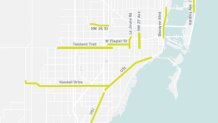Realtor Oscar Puig spends a lot of time in his car.
He has the same list of complaints as many who drive South Florida roads.
"It's pretty cumbersome," Puig said. "Cars everywhere, people not following the rules and traffic lights."
One busy road he uses a lot is Northwest 36th Street in Doral.
A one-mile stretch of that road between the 7100 block and 84th Avenue is part of a pilot program to test new adaptive or "smart" traffic signals.
The 2070 LX traffic controllers with adaptive traffic signal controls also include cameras and other detectors to gauge traffic in real time.
Bluetooth technology from passing driver’s mobile phones is one of the ways these adaptive signals track traffic. Cameras also help detect traffic flow.
Local
For example, when you’re stopped at a red light and there’s no cross traffic but you still can’t go. These signals could detect that and change the light to get traffic moving. The lights can even determine if the left turn signal needs to remain on longer.
Installation on the new adaptive signals along NW 36 started in September.
"Basically these signals are computers but they have eyes and ears," said Alice Bravo, the Director of Transportation in Miami-Dade County. "This smart signal can change the green timing and the red timing to get more cars through the intersection so you can hit as many green lights as possible.”
So far, tests done on the system show it's working to reduce the commute.
"We’ve tested it on seven intersections and it actually has decreased the traffic on an average of 10 percent," said Darlene Fernandez, a Miami-Dade traffic engineer.
In a nearly six-week test period, the signals cut five minutes a week in that mile stretch that was tested. The greatest reductions were in the afternoon rush where the westbound traffic is more spread out.
The belief is that as more of the signals are installed, the more time drivers will save.
“As we start deploying this throughout the county, we are going to have massive time-saving," said Bravo.
Ten congested corridors are next to get the smart signals. 300 intersections in all will get adaptive signals.
- US 1 from 152 St. to SW 16 Ave.
- Kendall Drive from Krome to US 1
- Tamiami Trail from SW 147 Ave to SW 67 Ave
- West Flagler St. from Milam Dairy Rd. to LeJeune Rd.
- LeJeune Rd from SW 8 St. to NW 21 St.
- NW 27 Ave. from SW 8 St. to NW 20 St.
- Biscayne Blvd from McArthur Causeway to NE 82nd St.
- Harding Ave/Indian Creek Dr from 6000 block Indian Creek to 95 St.
- NE 163 St. from NE 8 Ave to Dixie Hwy.
- NW 186 St. from NW 82 Ave. to NW 57 Ave.

The work to install the new signals will begin soon and should all be in place within the next 12 to 18 months. Each intersection costs the county about $50,000. The overall cost of the next phase of the project is $12 million.
J.C. Bermudez, Doral's Mayor, is glad his city was picked to be first.
"It certainly bodes well in the future," Bermudez said. "Technology is the key to improving traffic not only in Doral but in South Florida. We just can’t keep building more and more roads."
A Broward County official says adaptive signals could soon be coming to congested roads there too. A spokesperson said they have been researching the technology and could have a pilot project soon. The county is working with the state to target the Pines Blvd - I-75 interchange.



